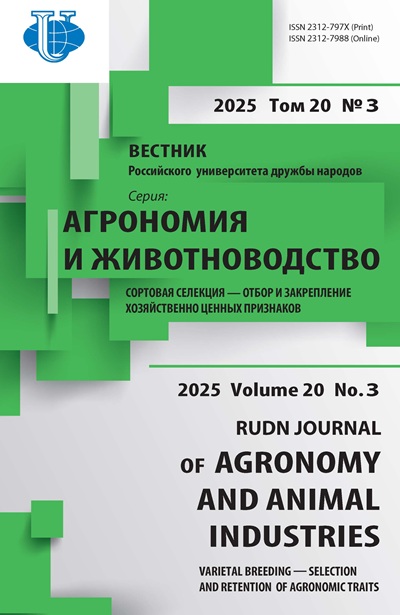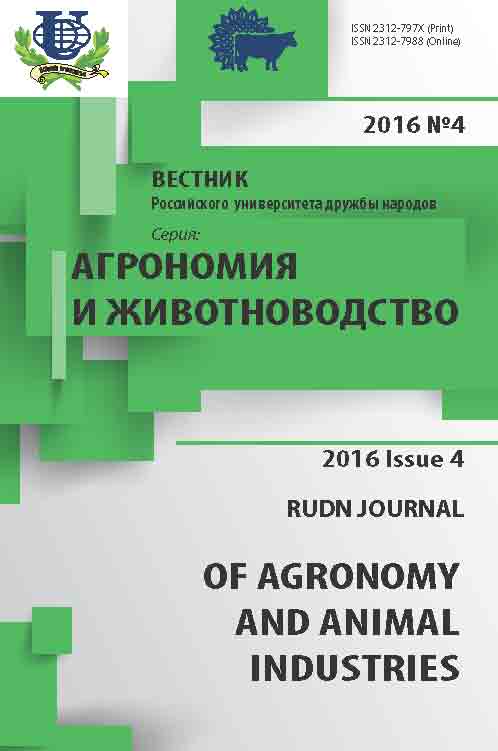Использование базального дыхания для апроксимации пространственного разнообразия эмиссии CO2 почвами Московской области
- Авторы: Васенев В.И.1, Штурвогель Е.J2, Плющиков В.Г.1, Ананьева Н.Д.3, Иващенко К.В.1, Ромзайкина О.Н.1
-
Учреждения:
- Российский университет дружбы народов
- Группа изучения Географии Почв и Ландшафтов
- Институт физико-химических и биологических проблем, РАН
- Выпуск: № 4 (2016)
- Страницы: 94-107
- Раздел: Статьи
- URL: https://agrojournal.rudn.ru/agronomy/article/view/14993
- DOI: https://doi.org/10.22363/2312-797X-2016-4-94-107
- ID: 14993
Цитировать
Полный текст
Аннотация
Ключевые слова
Об авторах
Вячеслав Иванович Васенев
Российский университет дружбы народов
Email: Vasenev_vi@pfur.ru
ул. Миклухо-Маклая, 8/2, Москва, Россия, 117198
Етце J Штурвогель
Группа изучения Географии Почв и Ландшафтов
Email: lisi4ka912@mail.ru
Университет Вагенинген, 47, Вагенинген, Нидерланды 6700 AA
Вадим Геннадьевич Плющиков
Российский университет дружбы народов
Email: v.g.plyushikov@mail.ru
ул. Миклухо-Маклая, 8/2, Москва, Россия, 117198
Надежда Дмитриевна Ананьева
Институт физико-химических и биологических проблем, РАН
Email: ananyeva@rambler.ru
Институтская ул., 2, Пущино, Московская область, Россия, 142290
Кристина Викторовна Иващенко
Российский университет дружбы народов
Email: ivashchenko-kv@rambler.ru
Институт физико-химических и биологических проблем, РАН Институтская ул., 2, Пущино, Московская область, Россия, 142290 ул. Миклухо-Маклая, 8/2, Москва, Россия, 117198
Ольга Николаевна Ромзайкина
Российский университет дружбы народов
Email: olrom92@mail.ru
ул. Миклухо-Маклая, 8/2, Москва, Россия, 117198
Список литературы
- Alexandrovskaya, E.I. and A.L. Alexandrovskiy. 2000. History of the cultural layer in Moscow and accumulation of anthropogenic substances in it. Catena 41: 249-259.
- Ananyeva N.D., E.A. Susyan, O.V. Chernova, and S. Wirth. 2008. Microbial respiration activities of soils from different climatic regions of European Russia. European Journal of Soil Biology 44: 147-157.
- Anderson TH, Domsch KH (1986) Carbon links between microbial biomass and soil organic matter / In: F. Megusar, M. Gantar (Eds.) Perspectives in Microbial Ecology. Slovene Society for Microbiology, Ljubljana, 467-471.
- Baldocchi D., E. Falge, L. Gu, R. Olson, D. Hollinger, S. Running, P. Anthoni, C. Bernhofer, K. Davis, R. Evans, J. Fuentes, A. Goldstein, G. Katul, B. Law, X. Lee, Y. Malhi, T. Meyers, W. Munger, W. Oechel, U.K.T. Paw, K. Pilegaard, H.P. Schmid, R. Valentini, S. Verma, T. Vesala, K. Wilson, S. Wofsy. 2001. FLUXNET: A New Tool to Study the Temporal and Spatial Variability of Ecosystem - Scale Carbon Dioxide, Water Vapor, and Energy Flux Densities. Bull. American Meteorol. Society 82: 2415-2434.
- Bekku, Y., H. Koizumi, T. Oikawa and H. Iwaki. 1997. Examination of four methods for measuring soil respiration. Applied Soil Ecology 5: 247-254.
- Bispo, A., D. Cluzeau, R. Creamer, M. Dombos, U. Graefe, P.H Krogh, J.P. Sousa, G. Peres, M. Rutgers, A. Winding and J. Römbke. 2009. Indicators for monitoring soil biodiversity. Integrated Environmental Assessment and Management 5: 717-719.
- Bloem, J. and Breure, A.M. (2003). Microbial indicators. In Markert, B.A., Breure, A.M., Zechmeister, H.G. (Eds.). Bioindicators and biomonitors (pp. 259-282). Oxford: Elsevier.
- Bloem, J., A.J. Schouten., S.J. Sørensen, M. Rutgers, A. Van der Werf and A.M. Breure. 2006. Monitoring and evaluating soil quality. In J. Bloem, A. Benedetti and D.W. Hopkins, editors. Microbiological Methods for Assessing Soil Quality. CAB International. Wallingford. Oxfordshire. UK.
- Bond-Lamberty, A. and A. Thomson 2010a. A global database of soil respiration data. Biogeosciences 7: 1915-1926.
- Bond-Lamberty, A. and A. Thomson 2010b. Temperature-associated increases in the global soil respiration record. Nature 464: 579-582.
- Borovikov, V. 2003. Art of computer data analysis. Piter. Saint-Petersburg.
- Buyanovsky, G. A., G. H. Wagner and C. J. Gantzer. 1986. Soil respiration in a winter wheat ecosystem. Soil Science Society of America Journal 50: 338-344.
- Carlyle, J.C. and U.B. Than. 1988. Abiotic controls of soil respiration beneath an eighteen-year old Pinusradiata stand in south-eastern Australia. Journal of Ecology 76: 654-662.
- Chapin, III F.S., G.M. Woodwell, J.T. Randerson, E.B. Rastetter, G.M. Lovett, D.D. Baldocchi, D.A. Clark, M.E. Harmon, D.S. Schimel, R. Valentini, C. Wirth, J.D. Aber, J.J. Cole, M.L. Goulden, J.W. Harden, M. Heimann, R.W. Howarth, P.A. Matson, A.D. McGuire, J.M. Melillo, H.A. Mooney, J.C. Neff, R.A. Houghton, M.L. Pace, M.G. Ryan, S.W. Running, O.E. Sala, W.H. Schlesinger and E.D. Schulze, 2006. Reconciling Carbon-cycle Concepts, Terminology, and Methods. Ecosystems 9: 1041-1050.
- Creamer, R.E., R.P.O. Schulte, D. Stone, A. Gal, P.H. Krogh, G.L. Papa, P.J. Murray, G. Peres, B. Foerster, M. Rutgers, J.P. Sousa and A. Winding. 2014. Measuring basal soil respiration across Europe: Do incubation temperature and incubation period matter? Ecological Indicators 36: 409-418.
- Egorov, V.V., V.M. Fridland, E.N. Ivanova, N.I. Rosov (Eds.). 1977. Classification and diagnostics of soils in USSR. Kolos. Moscow.
- FAO. 1988. Soils map of the world: revised legend. Food and Agriculture Organization of the United Nations, Rome.
- Fridland, V.M. (ed.). 1988. Soil Map of the Russian Soviet Federative Socialist Republic at scale 2.5 M. All Union Academy of Agricultural Science, Government Administration on Geodesy and Cartography (GUGK). USSR. 16 sheets.
- Gavrilenko, E.G., E.A. Susyan, N.D. Anan’eva and O.A. Makarov. 2011. Spatial Variability in the Carbon of Microbial Biomass and Microbial Respiration in Soils of the South of Moscow Oblast. Eurasian Soil Science 44: 1125-1138.
- Gomes-Casanovas, N., R. Matamala, D.R. Cook and M.A. Gonzalez-Meler. 2012. Net ecosystem exchange modifies the relationship between the autotrophic and heterotrophic components of soil respiration with abiotic factors in prairie grasslands. Global Change Biology 18: 2532-2545.
- Grimmond, C.S.B., T.S. King, F.D. Cropley, D.J. Nowak and C. Souch. 2002. Local-scale fluxes of carbon dioxide in urban environments: methodological challenges and results from Chicago. Environmental Pollution 116: 243-54.
- Hamilton, J.G., E.H. DeLucia, K. George, S.L. Naidu, A.C. Finzi and W.H. Schlesinger. 2002. Forest carbon balance under elevated CO2. Oecologia 131: 250-260.
- Harder, C., T. Ormsby and T. Balstrom. 2011. Understanding GIS: An ArcGIS project workbook. ESRI press.
- Houghton, R.A. 2003. Revised estimates of the annual net flux of carbon to the atmosphere from changes in land use and land management 1850-2000. Tellus 55B. 378-390.
- Huang N., J.S. He and Z. Niu. 2013. Estimating the spatial pattern of soil respiration in Tibetan alpine grasslands using Landsat TM images and MODIS data. Ecological Indicators 26: 117-125.
- Islam, K.R. and R R. Weil. 2000. Land use effects on soil quality in a tropical forest ecosystem of Bangladesh. Agriculture, Ecosystems and Environment. 79: 9-16.
- Jo, H.K. and E.G. McPherson. 1995. Carbon Storage and Flux in Urban Residential Greenspace. Journal of Environmental Management 45: 109-133.
- Kaye, J.P., R.L. McCulley and I.C. Burkez. 2005. Carbon fluxes, nitrogen cycling, and soil microbial communities in adjacent urban, native and agricultural ecosystems. Global Change Biology 11: 575-587.
- Kudeyarov, V.N., G.A. Zavarzin, S.A. Blagodatsky, A.V. Borisov, P.U. Voronin, V.A. Demkin, T.S. Demkina, I.V. Evdokimov, D.G. Zamolodchikov, D.V. Karelin, A.S. Komarov, I.N. Kurganova, A.A. Larionova, O.V. Lopes de Gerenu, A.I. Utkin, O.G. Chertov. 2007. Carbon pools and fluxes in terrestrial ecosystems of Russia. Nauka. Moscow.
- Kurganova, I.N. 2010. Emission and balance of carbon dioxide in terrestrial ecosystems of Russia. Doctoral thesis. Moscow State University. Moscow.
- Kurganova, I.N., V.O. Lopes de Gerenyu, T.N. Myakshina, D.V. Sapronov and V.N. Kudeyarov. 2011. CO2 Emission from soils of various ecosystems of the southern taiga zone: data analysis of continuous 12 year monitoring. Doklady Biological Sciences 436: 56-58.
- Kuzyakov, Y. and O. Gavrichkova. 2010. Review: Time lag between photosynthesis and carbon dioxide efflux from soil: A review of mechanisms and controls. Glob Change Biology 16: 3386-3406.
- Larionova, A.A., I.N. Kurganova, V.O.L. de Gerenyou, B.N. Zolotareva, I.V. Yevdokimov and V.N. Kudeyarov. 2010. Carbon dioxide emissions from agrogray soils under climate changes. Eurasian Soil Science 43: 168-176.
- Lorenz, K. and E. Kandeler. 2005. Biochemical characterization of urban soil profiles from Stuttgart, Germany. Soil Biology Biochemistry 37: 1373-1385.
- Lorenz, K. and R. Lal. 2009. Biogeochemical C and N cycles in urban soils. Environment International: 35, 1-8.
- Minasny B., A.B. McBratney, B.P. Malone and I. Wheeler. 2013. Digital mapping of soil carbon. Advances in Agronomy. 118. 1-47.
- Nakadai, T., H. Koizumi, Y. Usami, M. Satoh and T. Oikawa. 1993. Examination of the methods for measuring soil respiration in cultivated land: Effect of carbon dioxide concentration on soil respiration. Ecological Research 8: 65-71.
- Naumov V.D. (Ed.). 2009. 145 years to forest experimental station of RSAU-MTAA. RSAU-MTAA. Moscow.
- Nilsson, S., A. Shvidenko, V. Stolbovoi, M. Gluck, M. Jonas, M. Obersteiner. 2000. Full carbon account for Russia. Laxenburg.
- Nortcliff, S. 2002. Standardization of soil quality attributes. Agriculture, Ecosystems and Environment 88: 161-168.
- Pataki, D.E., R.J. Alig and A.S. Fung. 2006. Urban ecosystems and the North American carbon cycle. Global Change Biology 12: 2092-2102.
- Pell, M., J. Stenström and U. Granhall. 2006. Soil Respiration. In: Bloem J, Hopkins DW, Benedetti A (Eds.), Microbial Methods for Assessing Soil Quality. CAB International, Wallingford, Oxfordshire, U.K.
- Pickett, S.T.A., M.L. Cadenasso, J.M. Grove, C.G. Boone, P.M. Groffman, E. Irwin, S.S. Kaushal, V. Marshall, B.P. McGrath, C.H. Nilon, R.V. Pouyat, K. Szlavecz, A. Troy and P. Warren. 2011. Urban ecological systems: scientific foundations and a decade of progress. Journal of Environmental Management 92: 331-362.
- Pouyat, R.V., I.D. Yesilonis and D.J. Nowak, 2006. Carbon storage by urban soils in the United States. Journal of Environmental Quality 35: 1566-1575.
- Raich, J.W. and A. Tufekcioglu. 2000. Vegetation and soil respiration: correlations and controls. Biogeochemistry 48: 71-90.
- Russian Federation State Statistic Service (RFSSS). 2012. Population of Russian Federation. Moscow.
- Savage, K.E. and E.A. Davidson. 2003. A comparison of manual and automated systems for soil CO2 flux measurements: trade-offs between spatial and temporal resolution. Journal of Experimental Botany 54: 891-899.
- Scalenghe, R. and F.A. Marsan. 2009. The anthropogenic sealing of soil in urban areas, Landscape and urban planning 90: 1-10.
- Schulze, E.D. 2006. Biological control of the terrestrial carbon sink. Biogeosciences 2: 147-166.
- Shishov L.L. and N.V. Voinovich (Eds.). 2002. Soils of Moscow Region and Their Use. Dokuchaev Soil Science Institute. Moscow.
- Shishov, L.L., V.D. Tonkonogov, I.I. Lebedeva and M.I. Gerasimova. 2004. Classification and Diagnostics of Russian Soils. Dokuchaev Soil Science Institute, Moscow (in Russian).
- Smagin, A.V. 2005. Soil gas phase. Moscow University. Moscow (in Russian).
- Susyan, E.A., D.S. Rybyanets and N.D. Ananyeva. 2006. Microbial Activity in the Profiles of Gray Forest Soil and Chernozems. Eurasian Soil Science 39: 859-867.
- Trumbore, S. 2006. Carbon respired by terrestrial ecosystems - recent progress and challenges. Global Change Biology, 12: 141-153.
- Vasenev, V.I., N.D. Ananyeva and O.A. Makarov. 2012. Specific features of the ecological functioning of urban soils in Moscow and Moscow oblast. Eurasian Soil Science 45: 194-205.
- Vasenev, V.I., N.D Ananyeva and K.V. Ivachenko. 2013a. Influence of contaminants (oil products and heavy metals) on microbiological activity of urban constructed soils. Russian Journal of Ecology 6: 475-483.
- Vasenev, V.I., J.J. Stoorvogel and I.I. Vasenev. 2013b. Urban soil organic carbon and its spatial heterogeneity in comparison with natural and agricultural areas in the Moscow region. Catena. 107: 96-102.
- Vasenev, V.I., J.J. Stoorvogel, I.I. Vasenev and R. Valentini. 2014. How to map soil organic stocks in highly urbanized region? Geoderma 226-227: 103-115.
- Wardle, D.A. 1992. A comparative assessment of factors which influence microbial biomass carbon and nitrogen level in soil. Biological Review 67: 312-358.
- Wilson, K.B. and D.D. Baldocchi. 2000. Seasonal and interannual variability of energy fluxes over a broadleaved temperate deciduous forest in North America. Agricultural and Forest Meteorology 100: 1-18
- Winding, A., K. Hund-Rink and M. Rutgers. 2005. The use of microorganisms in eco-logical soil classification and assessment concepts. Ecotoxicology and Environmental Safety 62: 230-248.
- Yuste, J.C., D.D. Baldocchi, A. Gershenson, A. Goldstein, L. Misson and S. Wong. 2007. Microbial soil respiration and its dependency on carbon inputs, soil temperature and moisture. Global Change Biology 13: 2018-2035.
Дополнительные файлы















